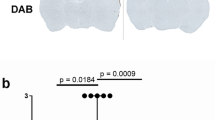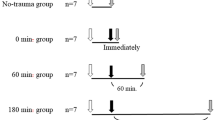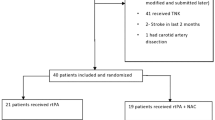Abstract
The clinical use of tissue-type plasminogen activator (tPA) in the treatment of stroke is profoundly constrained by its serious side effects. We report that the deleterious effects of tPA on cerebral edema and intracranial bleeding are separable from its fibrinolytic activity and can be neutralized. A hexapeptide (EEIIMD) corresponding to amino acids 350–355 of plasminogen activator inhibitor type 1 (PAI-1) abolished the tPA-induced increase in infarct size and intracranial bleeding in both mechanical and embolic models of stroke in rats, and reduced brain edema and neuronal loss after traumatic brain injury in pigs. These experiments suggest mechanisms to reduce the neurotoxic effects of tPA without compromising its fibrinolytic activity, through the use of selective antagonists and new tPA formulations.
This is a preview of subscription content, access via your institution
Access options
Subscribe to this journal
Receive 12 print issues and online access
$209.00 per year
only $17.42 per issue
Buy this article
- Purchase on Springer Link
- Instant access to full article PDF
Prices may be subject to local taxes which are calculated during checkout







Similar content being viewed by others
References
Zivin, J.A. Thrombolytic stroke therapy: past, present, and future. Neurology 53, 14–19 (1999).
Tsirka, S.E., Bugge, T.H., Degen, J.L. & Strickland, S. Neuronal death in the central nervous system demonstrates a non-fibrin substrate for plasmin. Proc. Natl. Acad. Sci. USA 94, 9779–9781 (1997).
Lapchak, P.A. & Araujo, D.M. Reducing bleeding complications after thrombolytic therapy for stroke: clinical potential of metalloproteinase inhibitors and spin trap agents. CNS Drugs 15, 819–829 (2001).
Lapchak, P.A. Hemorrhagic transformation following ischemic stroke: significance, causes, and relationship to therapy and treatment. Curr. Neurol. Neurosci. Rep. 2, 1–6 (2002).
Nagai, N., De Mol, M., Van Hoef, B., Verstreken, M. & Collen, D. Depletion of circulating α2-antiplasmin by intravenous plasmin or immunoneutralization reduces focal cerebral ischemic injury in the absence of arterial recanalization. Blood 97, 3086–3092 (2001).
Nassar, T. et al. The in vitro and in vivo effect of tPA and PAI-1 on blood vessel tone. Blood 103, 897–902 (2004).
Armstead, W.M., Cines, D.B. & Higazi, A.A.-H. Altered NO function contributes to impairment of uPA and tPA cerebrovasodilation after brain injury. J. Neurotrauma 21, 1204–1211 (2004).
Gennarelli, T.A. Animate models of human head injury. J. Neurotrauma 11, 357–368 (1994).
Armstead, W., Cines, D. & Higazi, A.A.-R. Plasminogen activators contribute to age-dependent impairment of NMDA cerebrovasodilation after brain injury. Brain Res. Dev. Brain Res. 156, 139–146 (2005).
Akkawi, S., Nassar, T., Tarshis, M., Cines, D.B. & Higazi, A.A.-R. LRP and αvβ3mediate tPA-activation of smooth muscle cells. Am. J. Physiol. Heart Circ. Physiol., published online 21 April 2006 (doi:10.1152/ajpheart.01042.2005).
Nagai, N., Vlinthout, D. & Collen, D. Comparative effect of tissue plasminogen activator, streptokinase and staphylokinase on cerebral ischemia infarction and pulmonary clot lysis in hamster models. Circulation 100, 2541–2546 (1999).
Zhang, Z. et al. Adjuvant treatment with neuroserpin increases the therapeutic window for tissue-type plasminogen activator administration in a rat model of embolic stroke. Circulation 106, 740–745 (2002).
Zhang, L., Strickland, D.K., Cines, D.B. & Higazi, A.A.-R. Regulation of single chain urokinase binding, internalization and degradation by a plasminogen activator inhibitor 1-derived peptide. J. Biol. Chem. 272, 27053–27057 (1997).
Adams, H., Adams, R., Del Zoppo, G. & Goldstein, L.B. Guidelines for the early management of patients with ischemic stroke: 2005 guidelines update a scientific statement from the stroke council of the American Heart Association/American Stroke Association. Stroke 36, 916–923 (2005).
Asahi, M., Asahi, K., Wang, X. & Lo, E.H. Reduction of tissue plasminogen activator-induced hemorrhage and brain injury by free radical spin trapping after embolic focal cerebral ischemia in rats. J. Cereb. Blood Flow Metab. 20, 452–457 (2000).
Higazi, A.A.-R. et al. Lysis of plasma clots by urokinase-soluble urokinase receptor complexes. Blood 92, 2075–2083 (1998).
Higazi, A.A.-R. et al. Regulation of the single-chain urokinase–urokinase receptor complex activity by plasminogen and fibrin: novel mechanism of fibrin specificity. Blood 105, 1021–1028 (2005).
Bdeir, K., Murciano, J.-C. & Tomaszewski, J. Urokinase mediates fibrinolysis in the pulmonary microvasculature. Blood 96, 1820–1826 (2000).
Atochin, D.N. et al. Mouse model of microembolic stroke and reperfusion. Stroke 35, 2177–2182 (2004).
Mori, T. et al. Reduced cortical injury and edema in tissue plasminogen activator knockout mice after brain trauma. Neuroreport 12, 4117–4120 (2001).
Madison, E.L. et al. Amino acid residues that affect interaction of tissue plasminogen activator with plasminogen activator inhibitor 1. Proc. Natl. Acad. Sci. USA 87, 3530–3534 (1990).
Madison, E.L., Goldsmith, E.J., Gething, M.-J.H., Sambrook, J.F. & Gerard, R.D. Restoration of serine protease-inhibitor interaction by protein engineering. J. Biol. Chem. 265, 21423–21426 (1990).
Duhaime, A. & Raghupathi, R. Age-specific therapy for traumatic injury of the immature brain: experimental approaches. Exp. Toxicol. Pathol. 51, 172–177 (1999).
Dickerson, J. & Dobbing, J. Prenatal and postnatal growth and development of the central nervous system of the pig. Proc. R. Soc. Lond. B Biol. Sci. 166, 384–395 (1967).
Pampiglione, G. Some aspects of development of cerebral function in mammals. Proc. R. Soc. Lond. B Biol. Sci. 64, 429–435 (1971).
Thomas, J. & Beamer, J. Age-weight relationship selected organs and body weight for miniature swine. Growth Factors 35, 259–272 (1971).
Buckley, N. Maturation of circulatory system in three mammalian models of human development. Comp. Biochem. Physiol. A 83, 1–7 (1986).
Wagerle, L., Humar, S. & Delivoria-Papadopoulos, M. Effect of sympathetic nerve stimulation on cerebral blood flow in newborn piglets. Pediatr. Res. 20, 131–135 (1986).
Rebich, S., Devine, J. & Armstead, W.M. The role of nitric oxide and cAMP in beta-adrenoceptor-induced pial artery vasodilation. Am. J. Physiol. 268, H1071–H1076 (1995).
Ding-Zhou, L., Marchand-Verrecchia, C., Croci, N., Plotkine, M. & Margaill, I. L-NAME reduces infarction, neurological deficit and blood-brain barrier disruption following cerebral ischemia in mice. Eur. J. Pharmacol. 457, 137–146 (2002).
Bdeir, K. et al. Urokinase contributes to fibrinolysis in the pulmonary microcirculation. Blood 96, 1820–1826 (2000).
Higazi, A.A.-R., Barghouti, I.I. & Abu-Much, R. Identification of an inhibitor of tissue-type plasminogen activator-mediated fibrinolysis in human neutrophils. J. Biol. Chem. 270, 9472–9477 (1995).
Felix, B. et al. Stereotaxic atlas of the pig brain. Brain Res. Bull. 49, 1–137 (1999).
Acknowledgements
This work was supported by the US National Institutes of Health (grants HL06831, HL076406, HL076206, HL82545 and HL67381), the University of Pennsylvania Research Foundation and the Israeli Science Foundation (grant 930/04).
Author information
Authors and Affiliations
Corresponding author
Ethics declarations
Competing interests
The authors declare no competing financial interests.
Rights and permissions
About this article
Cite this article
Armstead, W., Nassar, T., Akkawi, S. et al. Neutralizing the neurotoxic effects of exogenous and endogenous tPA. Nat Neurosci 9, 1150–1155 (2006). https://doi.org/10.1038/nn1757
Received:
Accepted:
Published:
Issue Date:
DOI: https://doi.org/10.1038/nn1757
This article is cited by
-
Tissue Plasminogen Activator Neurotoxicity is Neutralized by Recombinant ADAMTS 13
Scientific Reports (2016)
-
Longitudinal Assessment of Imatinib’s Effect on the Blood–Brain Barrier After Ischemia/Reperfusion Injury with Permeability MRI
Translational Stroke Research (2015)
-
Plasmin-Dependent Modulation of the Blood–Brain Barrier: A Major Consideration during tPA-Induced Thrombolysis?
Journal of Cerebral Blood Flow & Metabolism (2014)
-
Tissue Plasminogen Activator Induced Delayed Edema in Experimental Porcine Intracranial Hemorrhage: Reduction with Plasminogen Activator Inhibitor-1 Administration
Translational Stroke Research (2012)
-
Impact of Tissue Plasminogen Activator on the Neurovascular Unit: From Clinical Data to Experimental Evidence
Journal of Cerebral Blood Flow & Metabolism (2011)



